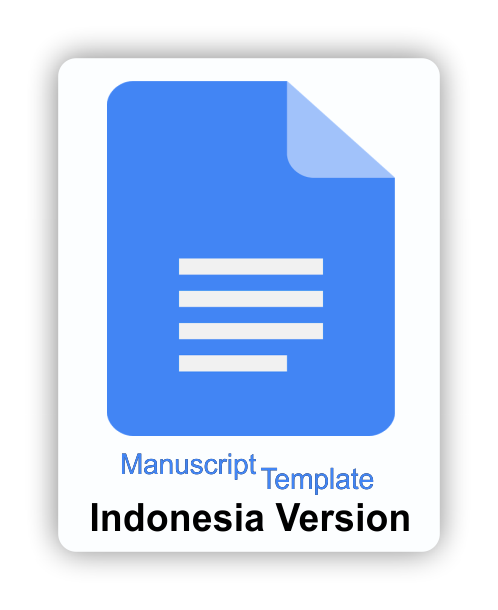Penerimaan mahasiswa terhadap pembelajaran daring selama pandemi Covid-19 dengan pendekatan Technology Acceptance Model (TAM)
Sulis Rokhmawanto, Institut Agama Islam Nahdlatul Ulama (IANU) Kebumen, Indonesia
Purwanto Purwanto, (Scous ID: 57225952725) STAI Al Husain Magelang, Indonesia
Laili Syarifah, STAI Al Husain Magelang, Indonesia
Abstract
Pandemi Covid-19 memberikan perubahan dalam proses pembelajaran di lembaga pendidikan termasuk pada pendidikan tinggi. Perubahan tersebut dapat dilihat dari pelaksanaan pembelajaran dalam satu tahun terakhir yang harus dilaksanakan secara daring. Pembelajaran daring dilaksanakan guna mendukung kebijakan pemerintah berupa Pembatasan Berskala Besar (PSBB). Para dosen telah berupaya melaksanakan pembelajaran daring dengan menggunakan berbagai aplikasi yang telah tersedia seperti zoom meeting, google meet, quiz dan aplikasi lainnya. Penelitian ini bertujuan untuk membuktikan secara empiris terkait intention to use dalam pembelajaran daring dengan attitude sebagai variabel mediasi. Data penelitian sebanyak 297 yang dikumpulkan secara daring. Responden penelitian merupakan mahasiswa aktif di berbagai perguruan tinggi yang ada di Kabupaten Magelang. Data penelitian dianalisis structural equation modeling dengan menggunakan software Smart PLS. Hasil pengujian membuktikan bahwa pedagogic competence, perceived ease of use dan perceived usefulness dapat mempengaruhi attitude. Hasil pengujian lainnya membuktikan perceived usefulness dan attitude berpengaruh terhadap intention to use, namun pedagogic competence tidak terbukti. Hasil pengujian pengaruh tidak langsung dapat diketahui bahwa attitude dapat memediasi hubungan antara pedagogic competence, perceived ease of use dan perceived usefulness terhadap intention to use.
Student acceptance of online learning during the Covid-19 pandemic with the Technology Acceptance Model approach
Abstract
Covid-19 pandemic provided a change in the learning process in educational institutions included in higher education. These changes could be seen from the implementation of learning in the past year which should be implemented online. Online learning was be implemented to support government policies in the form of Large-Scale Restrictions (PSBB). The lecturers had made efforts to implement online learning by using various available applications such as zoom meetings, google meet, quizzes, and other applications. This study aims to prove empirically the intention to use online learning with attitude as a mediating variable. The research data were 297 collected online. Research respondents were active students in various universities in Magelang Regency. The research data were analyzed structural equation modeling using Smart PLS software. The test results prove that pedagogic competence, perceived ease of use, and perceived usefulness could affect attitude. Other test results prove that perceived usefulness and attitude had an effect on the intention to use, but pedagogic competence is not proven. The results of the indirect effect test show that attitude can mediate the relationship between pedagogic competence, perceived ease of use, and perceived usefulness for intention to use.
Keywords
Full Text:
PDFReferences
Al-Adwan, A., Al-Adwan, A., & Smedley, J. (2016). Exploring students acceptance of e-learning using Technology Acceptance. International Journal of Education and Development Using Information and Communication Technology, 9(2), 4–18.
Al-Gahtani, S. S. (2016). Empirical investigation of e-learning acceptance and assimilation: A structural equation model. Applied Computing and Informatics, 12(1), 27–50. https://doi.org/10.1016/j.aci.2014.09.001
Alradhawi, M., Shubber, N., Sheppard, J., & Ali, Y. (2020). Effects of the Covid-19 pandemic on mental well-being amongst individuals in society: A letter to the editor on “The socio-economic implications of the coronavirus and Covid-19 pandemic: A review”. International Journal of Surgery, 78, 147–148. https://doi.org/10.1016/j.ijsu.2020.04.070
Chawala, D., & Joshi, H. (2019). Consumer attitude and intention to adopt mobile wallet in India – An empirical study. International Journal of Bank Marketing, 37(7), 1590–1618. https://doi.org/https://doi.org/10.1108/IJBM-09-2018-0256
Davis, F. D. (1989). Perceived usefulness, perceived ease of use, and user acceptance of information technology. MIS Quarterly, 13(3), 319–340. https://doi.org/10.5962/bhl.title.33621
de Leeuw, E. D. (2008). Choosing the method of data collection. Lawrence Erlbaum Associates.
Eagly, A. H., & Chaiken, S. (2007). The Advantages of An Inclusive Definition of Attitude. Social Cognition, 25(5), 582–602.
Fathema, N., Shannon, D., & Ross, M. (2015). Expanding The Technology Acceptance Model (TAM) to Examine Faculty Use of Learning Management Systems (LMSs) In Higher Education Institutions. MERLOT Journal of Online Learning and Teaching, 11(2), 210–232.
From, J. (2017). Pedagogical Digital Competence—Between Values, Knowledge and Skills. Higher Education Studies, 7(2), 43. https://doi.org/10.5539/hes.v7n2p43
Gottems, L. B. D., Carvalho, E. M. P. De, Guilhem, D., & Pires, M. R. G. M. P. (2018). Good Practices in Normal Childbirth: Reliability Analysis of an Instrument by Cronbach ’ s Alpha. Revista Lationo-Americana de Efermagem, 26(3), 1–8. https://doi.org/10.1590/1518-8345.2234.3000
Hair, Joe F, Ringle, C. M., & Sarstedt, M. (2011). PLS-SEM: Indeed a silver bullet. Journal of Marketing Theory and Practice, 19(2), 139–152. https://doi.org/10.2753/MTP1069-6679190202
Hair, Joseph F., Risher, J. J., Sarstedt, M., & Ringle, C. M. (2019). When to use and how to report the results of PLS-SEM. European Business Review, 31(1), 2–24. https://doi.org/10.1108/EBR-11-2018-0203
He, Y., Chen, Q., & Kitkuakul, S. (2018). Regulatory Focus and Technology Acceptance: Perceived Ease of use and Usefulness as efficacy. Cogent Business and Management, 5(1), 0–22. https://doi.org/10.1080/23311975.2018.1459006
Henseler, J., Ringle, C., & Sinkovics, R. (2009). The use of partial least squares path modeling in international marketing. Advances in International Marketing, 20, 277–319. https://doi.org/https://doi.org/10.1108/S1474-7979(2009)0000020014
Holden, H., & Rada, R. (2011). Understanding the influence of perceived usability and technology self-efficacy on teachers’ technology acceptance. Journal of Research on Technology in Education, 43(4), 343–367. https://doi.org/10.1080/15391523.2011.10782576
Hossen, M. M., Chan, T. J., & Hasan, N. A. M. (2020). Mediating role of job satisfaction on internal corporate social responsibility practices and employee engagement in higher education sector. Contemporary Management Research, 16(3), 207–227. https://doi.org/10.7903/CMR.20334
Ibrahim, R., Leng, N. S., Yusoff, R. C. M., Samy, G. N., Masrom, S., & Rizman, Z. I. (2018). E-learning acceptance based on technology acceptance model (TAM). Journal of Fundamental and Applied Sciences, 9(4S), 871. https://doi.org/10.4314/jfas.v9i4s.50
Jayalath, C., Wickramasinghe, U., Kottage, H., & Somaratna, G. (2020). Factors influencing orderly transition to online deliveries during Covid-19 pandemic impact. Asian Journal of Education and Social Studies, 9(2), 10–24. https://doi.org/10.9734/ajess/2020/v9i230242
Ma, Y. J., Gam, H. J., & Banning, J. (2017). Perceived ease of use and usefulness of sustainability labels on apparel products: application of the technology acceptance model. Fashion and Textiles, 4(3), 1–20. https://doi.org/10.1186/s40691-017-0093-1
Masrom, M. (2007). Technology acceptance model and E-learning. 12th International Conference on Education, May, 21–24.
Memon, Y. J., Azhar, S. M., Haque, R., & Bhutto, N. A. (2019). Religiosity as a moderator between theory of planned behavior and halal purchase intention. Journal of Islamic Marketing, 10(4), 1351–1372.
Moakofhi, M. K., Phiri, T. V., Leteane, O., & Bangomwa, E. (2019). Using Technology Acceptance Model to Predict Lecturers’ Acceptance of Moodle: Case of Botswana University of Agriculture and Natural Resources. Literacy Information and Computer Education Journal, 10(1), 3103–3113. https://doi.org/10.20533/licej.2040.2589.2019.0407
Mulyanti, B., Purnama, W., & Pawinanto, R. E. (2020). Distance learning in vocational high schools during the Covid-19 pandemic in West Java Province, Indonesia. Indonesian Journal of Science & Technology, 5(2), 96–107. https://doi.org/https://doi.org/10.17509/ijost.v5i2.24640
Ngampornchai, A., & Adams, J. (2016). Students’ acceptance and readiness for E-learning in Northeastern Thailand. International Journal of Educational Technology in Higher Education, 13(1). https://doi.org/10.1186/s41239-016-0034-x
Panggabean, M. S., & Himawan, K. K. (2016). The development of Indonesian teacher competence questionnaire. Journal of Educational, Health and Community Psychology, 5(2), 1. https://doi.org/10.12928/jehcp.v5i2.5134
Pradana, F., Bachtiar, F. A., & Priyambadha, B. (2019). Penilaian Penerimaan Teknologi E-Learning Pemrograman berbasis Gamification dengan Metode Technology Acceptance Model (TAM). Jurnal Teknologi Informasi Dan Ilmu Komputer, 6(2), 163. https://doi.org/10.25126/jtiik.2019621288
Purwanto. (2021). Society Attitudes and Intentions To Use Products In Sharia Bank of Aceh: The Role of Religiosity and Social Influence. ABAC Journal, 41(2), 223–242.
Rahmawati, R. N. M. N. (2019). Actual Usage Use of E-Learning With Technology Acceptance Model (TAM). Jurnal Inovasi Teknologi Pendidikan, 6(2), 127–136.
Ramirez-Anormaliza, R., Sabaté, F., & Guevara-Viejo, F. (2015). Evaluating Student Acceptance Level of E-Learning Systems. 8th Annual International Conference of Education, Research and Innovation, November, 2393–2399. http://library.iated.org/view/RAMIREZANORMALIZA2015EVA
Retnowati, E., Murdiyani, N. M., Marsigit, Sugiman, & Mahmudi, A. (2018). Improving pedagogic competence using an e-learning approach for pre-service mathematics teachers. Journal of Physics: Conference Series, 983(1). https://doi.org/10.1088/1742-6596/983/1/012126
Salloum, S. A., Qasim Mohammad Alhamad, A., Al-Emran, M., Abdel Monem, A., & Shaalan, K. (2019). Exploring students’ acceptance of e-learning through the development of a comprehensive technology acceptance model. IEEE Access, 7(2), 45–62. https://doi.org/10.1109/ACCESS.2019.2939467
Sholihin, M., & Ratmono, D. (2013). Analisis SEM-PLS dengan WarpPLS 3.0 untuk hubungan nonlinier dalam penelitian sosial dan bisnis. Andi.
Singarimbun, M., & Effendi, S. (2016). Metode Penelitian Survai. LP3S.
Streukens, S., & Leroi-Werelds, S. (2016). Bootstrapping and PLS-SEM: A step-by-step guide to get more out of your bootstrap results. European Management Journal, 34(6), 1–15. https://doi.org/10.1016/j.emj.2016.06.003
Sukainah, A., Reski, P. P., Fadilah, R., & Mustarin, A. (2019). Application of Technology Acceptance Model to E-learning Assessment (Kelase) in Agricultural Technology Education, UniversitasNegeri Makassar. Journal of Physics: Conference Series, 1387(1). https://doi.org/10.1088/1742-6596/1387/1/012115
Tehseen, S., Ramayah, T., & Sajilan, S. (2017). Testing and Controlling for Common Method Variance: A Review of Available Methods. Journal of Management Sciences, 4(2), 142–168. https://doi.org/10.20547/jms.2014.1704202
Vululleh, P. (2018). Determinants of students’ e-learning acceptance in developing countries: An approach based on Structural Equation Modeling (SEM). International Journal of Education and Development Using Information and Communication Technology, 14(1), 141–151.
Yuen, A. H. K., & Ma, W. W. K. (2008). Exploring teacher acceptance of e-learning technology. Asia-Pacific Journal of Teacher Education, 36(3), 229–243. https://doi.org/10.1080/13598660802232779
Ziadat, M. T. A. L. (2015). Applications of Planned Behavior Theory (TPB) in Jordanian Tourism. International Journal of Marketing Studies, 7(3), 95–106. https://doi.org/10.5539/ijms.v7n3p95
DOI: https://doi.org/10.21831/jitp.v8i2.39755
Refbacks
- There are currently no refbacks.
Copyright (c) 2021 Nur Latifah, Sulis Rokhmawanto, Purwanto Purwanto, Laili Syarifah

This work is licensed under a Creative Commons Attribution-ShareAlike 4.0 International License.
Our journal indexed by:
View Journal Statistics


















.png)